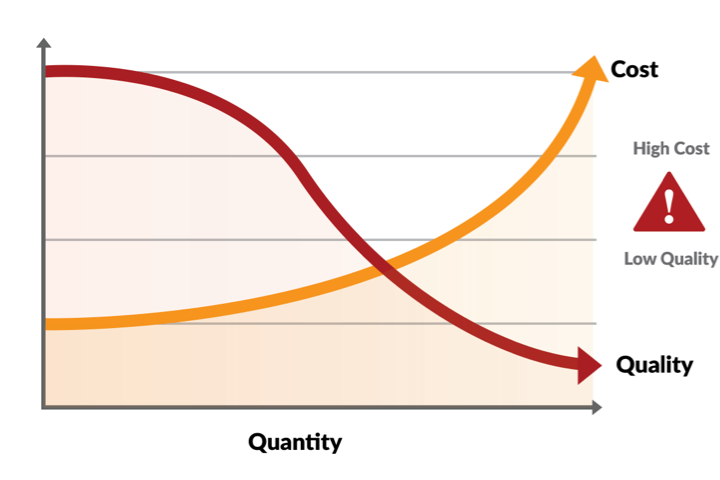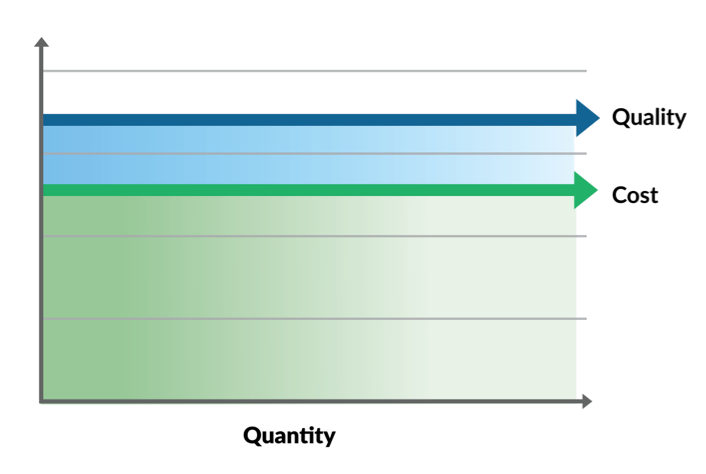The New State of Demand Generation:
5 Essential Ways To Adapt Your Lead Gen
We know that the events of the last few years shook up the very foundations of lead generation, but what can modern businesses do to ensure they keep up and keep moving forward? Physical meetings, conferences, and in-person engagements have become things of the past. Demand generation teams are scrambling to find ways to shift gears as they navigate new strategies and tactics to generate more leads and close more deals. Now is the time to adapt your suddenly outdated strategies so you can still triumph during increasingly uncertain times, rather than fall behind because you didn’t pivot when you still had the chance.
So to help you do just that, we’ve put together five actionable steps you can take to move your business forward and generate high-quality leads that are ready for your pipeline.
“Now is the time to adapt your suddenly outdated strategies so you can still triumph during increasingly uncertain times, rather than fall behind because you didn’t pivot when you still had the chance.”
Tactic #1:
Dedicate a healthy portion of your lead gen budget to the digital world
In 2022, the average time Americans spend on digital media every day is a whopping 492 minutes. That’s just over eight hours!(source: Statista)
It’s a no-brainer that businesses need to dedicate a large portion of their demand generation budget to the digital world. A significant piece of the workforce has continued to work from home, and as a result, are spending more time on their digital devices than ever before. Digital consumption is rising exponentially, advertising networks are reporting record-breaking traffic, and we’re seeing consistently high digital conversion rates.
All of this tells us that businesses have a unique opportunity to invest in digital inbound campaigns so they can reach prospective customers exactly where they already are. With marketing initiatives that originally relied on conferences, in-person engagements, and call centers drying up and not yielding the necessary lead quantities or lead quality, the most strategic channel for you to divert these budgets to would be digital. Data-driven targeting across all major networks gives you access to your ideal prospect throughout their digital journey, and these mid-to-lower funnel leads are more qualified and a better utilization of your resources and sales efforts.
As you start depending on your digital advertising budget to generate your leads, you have a solution that can be incorporated into your marketing mix no matter the global climate, and a strategy that will stand the test of time.
Tactic #2:
Focus your goals and messaging on generating sales-ready leads
The old adage that quality is better than quantity has never been more true for marketers. This is a trend we were seeing well before the pandemic, but now it’s more important than ever: executives are completely focused on demo set rates and win rates. This means that marketing managers and sales managers will be more aligned in hitting goals and KPIs than ever before, and as a result, leads that are generated by marketers need to be sales-ready.
So what is a sales-ready lead, anyway? We define a sales-ready lead as a prospect that has willingly and voluntarily booked a meeting or filled out a lead form, in exchange for a promise that they can learn more about a company’s specific product or service. They are leads that are high-intent and job title qualified. These are the “holy grail” of leads, and the industry will now be viewing them as the rule, not the exception.
Here are a few tips to help you ensure that every single lead generated is sales-ready:
- Use deterministic audiences to target ONLY your ideal customer
- Create and share high-value content that primes your users to request a demo
- Optimize your spending based on qualified conversions and opportunities
- Identify which of your ads, offers, and assets are bringing in the most demo requests, and put your resources towards improving those or producing more
Tactic #3:
Launch a program that will generate both awareness and inbound leads from a high-quality audience
We often hear marketers brag about getting “cheap leads.”
New marketers might not see the immediate problem with this, but the reality is that whatever you save now in acquiring low-cost leads, you’ll pay for in higher long-term costs eventually.
This is simply because the more “dead ends” you accumulate, the higher the cost of conversion. Low-quality, cheap leads have little to no interest in buying your product or service, and your sales team will discover this after they’ve already poured significant time and effort into them.
What’s more, MarketingProfs recently estimated that bad prospect data can actually cost the average sales department 550 hours in wasted labor and $32,000 for every sales representative that uses bad prospect data. Because of this, more executives are holding their marketing and demand managers accountable for the ROI of their lead gen initiatives, and trimming anything that isn’t delivering.
Tip: take a closer look at your cost-per-acquisition and you might find that a large chunk of your budget and resources cost is going toward chasing leads that shouldn’t have been in your pipeline to begin with. Generating leads from lookalike audiences usually means you’re wasting impressions and dollars on unqualified eyes…and even if they happen to become leads, they’ll be quickly disqualified, at the expense of your sales team’s time and energy.
With that in mind, we suggest you calculate a CPA that makes sense for your growth goals and start shifting your focus AND your budget to a programmatic advertising source that will eventually deliver higher quality, deeper funnel inbound leads. When you know that every click you pay for is coming from your exact target audience, it’s much easier to prove ROI and see long-term results.
Tactic #4:
Introduce AI-driven solutions to automate your marketing efforts
The OECD reported that Covid-19 triggered one of the worst staffing crises since The Great Depression. Thousands of businesses have been grappling with staffing issues, whether they’ve been struggling to keep their employees on, or making tough decisions to reduce headcount.
To efficiently navigate this massive challenge, more modern businesses are expecting their teams to be more nimble than ever, and turning to automation and AI in order to stay afloat without making further dents into revenue.
When it comes to the changes in the demand generation landscape, for example, we often hear that attribution is one of the most time-consuming parts of the advertising and lead generation process. But attribution has already proved more necessary than ever when it comes to proving ROI—requiring marketers to be able to track wins all the way back to the first digital “click.”
The question marketers should be asking is “how can these time-consuming, manual processes be automated?” If your team is now leaner, and you don’t want to stretch your budget to bring on new hires, you can integrate powerful automation and AI solutions into your existing MarTech stack that won’t require exorbitant staff training or thousands of dollars to maintain.
As you look for solutions that use AI to automate your most time-consuming tasks, remember that tracking your data will now be key. People are creating more data points than ever. Make sure you are keeping track of all the granular details of your campaigns so that as they continue to run, you can create more data points that will help you successfully adapt to any new tech you decide to implement.
Here are a few questions to consider when searching for the right automation tools to streamline your workflows:
- Can you integrate it seamlessly into your existing workflows and stacks?
- Is it easy to use? Will you need to put time aside to train employees on how to use it?
- Does the solution require any special skills or knowledge to use it efficiently?
- Is the tool versatile? Can you use it to automate both simple and complex processes?
- Can it scale as quickly as you need it to?
- Is it within your budget?
- Will you have a partner team available for assistance?
Tactic #5:
Ensure your lead generation process is scalable, in order to see lasting growth
As this new era of demand generation comes with increased uncertainty, companies will need to think about what will provide long-term success, rather than just focusing on the present quarter.
Solutions that can’t be scaled won’t lead to growth. Demand gen will ebb and flow cyclically and will depend on your company’s unique quarterly and monthly goals. But in order to ensure lasting growth, you’ll need to provide accurate projections for how many sales-qualified leads you’ll be delivering to the sales team. If your sales teams need more leads, you’ll need to be able to increase the number of leads without sacrificing quality or stocking up on those cheap leads we mentioned earlier.
The industry standard for lead gen usually follows the law of diminishing returns and looks like the graph below. When the sales team requests a higher quantity of leads, the solutions marketers have been depending on start to significantly dip in quality, while cost starts to drive up dangerously high. But “It’s impossible to scale” isn’t an answer that executives can afford to settle for anymore when trying to experience growth.

The below graph shows a healthy, fully scalable program that ensures highly qualified leads while maintaining a consistent cost, even with increased quantity goals. This offers the predictability and scalability that executives need in order to forecast and hit their goals. Your final challenge in this new era of demand generation is to provide a solution that offers predictable scalability and control over the volume of inbound leads based on your growth goals while adapting and adjusting your messaging enough to keep your CPL constant.

Your final challenge in this new era of demand generation is to provide a solution that offers predictable scalability and control over the volume of inbound leads based on your growth goals while adapting and adjusting your messaging enough to keep your CPL constant.
Get started on generating sales-ready inbound leads with Genly
Disruption is typically followed by growth, and marketers now have a unique opportunity to test out demand generation strategies that can lead to sustainable scalability for years to come.
From changing the way businesses operate all the way to consumer engagement, B2B companies are changing their marketing strategies to adapt to the “new normal” as the media has termed it, and adapting demand strategies is at the top of the priority list.
Want to get a head start on generating the inbound demand that your team needs in order to reach your goals?
Genly is currently partnering with B2B companies to feed their sales teams with qualified inbound traffic daily, and has a proprietary AI bot designed to integrate with your CRM and optimize your media buy based on the ads, forms, and audiences that are leading to the highest demo set and win rates. If you’re ready to empower your sales teams with the demand they need, create an account to get started.